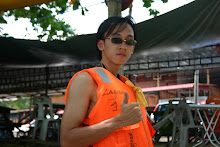This was my first time participating for the Penang Bridge Run, which is considered to be one of the major running events in Malaysia. Well, for the sake of experiencing it and to add into my medals collection of different races, I volunteered to drive with Kenny & wife and Rujhan car pooling with me.
Took off from home at 9.30ish and stopped for lunch at Bidor for the famous wantan mee (recommended by pm1). Reached Penang at around 3pm and checked in at Krystal Suite. At around 5pm, off we went for our final carbo loading and dinner at a nearby hawker centre known as Super Tanker. Stuffed myself with a plate of Char koay Teow and chicken rice. It was delicious. Everyone planned to sleep at around 9pm as we need to wake up at 2am. Could hardly sleep though, due to the new "atmosphere" plus the sheer kancheongness whenever there is a race the following day. Woke up at 2am, grabbed some bread and energy bars for breakfast and immediately changed into my running gears: Adidas Orange vest (KOTR 09), Adidas running shorts, Nike Elite DryFit socks, New Balance RC1002 racer.
Felt tireness and aching on my legs especially on the calfs. It could be due some muscle strain which failed to recover in time after weeks of hard training. At around 2.45am, off we went to the starting point which is only 10mins jog from the hotel. I took it as a warm up prior to the race. Upon reaching, the huge crowd had already started booking their place at the starting line. As usual, I would take my time to do some stretchings at the side near the front and only make my way as near as possible to the front when it is 5min to start.
Guns off.. the race started with people pushing against each other. Due to the small space of the exit from the starting line, I've wasted about 2min of time just to find a clear passageway to run. Started with a comfortable 4:30 pace, pacing which Ronnie (pm1) all the way to the bridge. We overtook many runners along the way and even some were from the Full Marathon batch which had started about an hour earlier. Pm1 and I exchanged lead several times with him having the upperhand at the hills while I having the upperhand at the flats. Everytime there is a water station, pm1 would create some gap from me as he is such as fast drinker. That's one skill I need to learn in racing. The weather was good that day with the wind blowing against me making it abit dry and thirsty. Made a u-turn at 10km mark on the bridge where my time was 42.56. Things were looking good from there and I got myself mentally ready to finish the 2nd half of the race. Hopefully can achieve my target of 1hr30min.
Disaster happened at the 15km mark, where cramps started to hit my left calf. At the water station around 15km or 16km mark, I stopped for a moment quenching my thirst and doing some quick stretching on my calfs. Pm1 was already 100m ahead of me that time and he was on firery form that day. There goes my hope of beating him for the first time in half marathon. Struggled through the remaining few kms where my pace slowed doing substantially due to the cramps. The last 2km seemed to be a journey that last forever. Completed the race with a time of 1.36.32 which is a PB for me but still far from my targeted time of 1.30. Will try again next time.
Felt so tired after the race and I was unable to fall asleep due to the overexhaustion. Lied down on the bed and started to contemplate on what went wrong during the race. There were a few key factors which I had concluded that needs improvement on my part for me to improve next time.
1) Sufficient LSD - I find that I'm lacking in LSDs in my training schedule which may have caused my legs not being used to running long distance at a fast pace. Most of my trainings had been focused mainly on speed and tempo runs.
2) Recovery - Having most of my trainings carried out in a high intensity fashion may have prevented my muscles from recovering fully. The could be the reason behind the muscle soreness. I would need to include some easy runs in my training schedule.
3) Mental strength - I may have done well in the first 15km, but it is the last 5km that matters. This is where most experienced runners will rely on their mental strength to carry them through eventhough the feeling of tireness is overwhelming. How can I gather more mental strength? Some people said it is from the experience gained by participating in many races but I don't have the luxury of joining so many races due to priority reasons.
4) Hydration - Rushing through all the water stations may have also contributed to the cramps where dehydration is one of the main causes of muscle cramp. I think the reason I did this is because I don't want to loose gap from pm1 who happened to my pacer that day.
There may be more, but I felt that if all the above were done correctly, wonders can happen. The best part of the trip started after the race. It was the "Makan adventure" in Penang with pm1 being our tour guide as he is a "Penang Lang". Spent the rest of the day at a Resort where we stayed overnight in a chalet, thanks to our friend Rujhan for booking. Everyone made a trip back to KL on monday.






